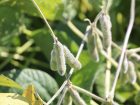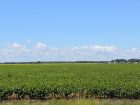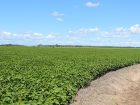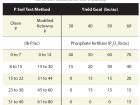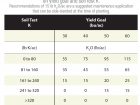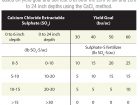
Features
Agronomy
Soybeans
Nutrient management of soybean
Soybean production has rapidly expanded in Manitoba in the past few years and there is increasing interest in Saskatchewan and Alberta. If you can successfully grow soybean, it is a great crop to include in your rotation and farm management program.
January 24, 2017 By Ross H. McKenzie PhD P. Ag.
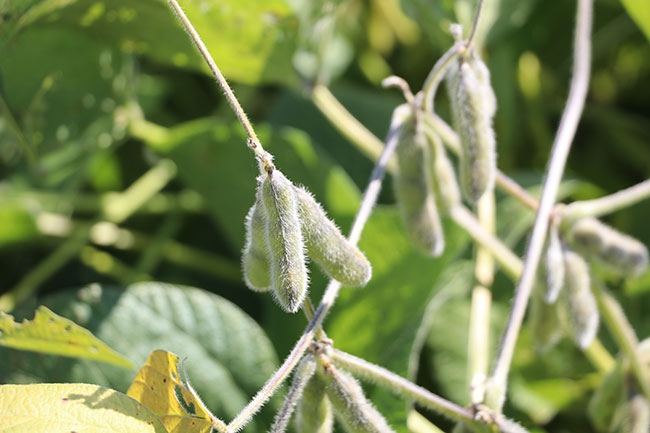 Phosphate fertilizer does not have a strong effect on soybean growth or yield. Soybean production has rapidly expanded in Manitoba
Phosphate fertilizer does not have a strong effect on soybean growth or yield. Soybean production has rapidly expanded in ManitobaFirst, it is important for new growers to realize soybean requires a considerable amount of heat for optimum production. The region you farm should consistently receive a minimum of 2,200 to 2,300 crop heat units (CHU) each year. Remember that Crop Heat Units are calculated differently than growing degree days. Crop heat units are calculated on a daily basis and have separate calculations for maximum and minimum temperatures. Most companies have a CHU rating for each soybean variety. For the area you farm, don’t review CHU maps that were produced before 2000, because most areas of the Prairies are slightly warmer with longer growing seasons now versus 30 to 50 years ago. Look at the CHU calculated using weather data from metrological stations for the region you farm, each year, for the past 10 years. If for nine of the past 10 years the CHU for your area has been greater than 2,200, then the probability of successfully growing soybeans is reasonably good.
Importance of soil sampling and testing
Soil sampling and testing can give an excellent inventory of plant available nutrients and other soil chemical factors important for soybean production. This inventory can provide a very good basis for recommending additional nutrients on individual fields.
Soil nutrient levels vary from year to year and can be quite variable within fields, even on fields that seem to be relatively uniform. Producers need to follow certain recommended steps for soil sampling and testing to develop a sound ongoing soil fertility management program. Poor soil sampling technique is a major problem that can cause variation in fertilizer recommendations. Make sure you work with qualified people to soil sample your fields.
Begin by evaluating each field to determine representative areas. Major areas within fields that have distinctly different soil properties, such as texture, should be sampled and fertilized as separate units due to variation in soil nutrient availability. Samples should be taken at zero to six, six to 12 and 12 to 24 inch depths from at least 20 locations within each field or soil management area of each field and bulked into composite samples.
Nitrogen recommendations for soybean
Nitrogen (N) fertilizer is rarely recommended for soybean, even if the soil test N level is low and it is the first time soybean will be grown on virgin land. Elevated soil nitrate levels may increase the likelihood for excess vegetative growth, reduced nitrogen fixation, increased disease pressure or delayed maturity.
Inoculants and nitrogen fixation
Rhizobia bacteria infect soybean roots to form nodules. The bacteria within the nodules use energy from the soybean plant and, in return, provide usable N to the plant. As a result, much of the N required by soybean is provided from bacterial N fixation and any additional N comes from the soil. This eliminates the need to add N fertilizer. Inoculation with Bradyrhizobium japonicum bacteria is essential to ensure fixation. Make certain the inoculant is fresh and has been stored as recommended by the manufacturer. There are three main types of inoculants:
- Powdered – fine peat containing the rhizobium, applied directly to the seed.
- Liquid – contains the rhizobium in a buffered liquid, applied directly to the seed and is held in place using a sticker.
- Granular – small peat-based granules contain the rhizobium, applied in the seedrow.
On virgin land that has never produced soybean, growers should consider double inoculation. For example, consider using liquid inoculant on the seed and granular inoculant in the seedrow.
Remember: it takes three to five weeks after seeding for the bacteria to infect plant roots and form viable nodules. The effectiveness of the inoculation process can be assessed by simply digging up plants and observing the number, size, colour and distribution of the nodules. Nodules on roots close to the original location of the seed that are reddish or pink inside indicate the bacteria are functioning and fixing N. Nodules are likely not fixing N when they appear white, grey or greenish when cut in half.
Nodules widely distributed throughout the root system indicate soil bacteria have also infected the roots. These bacteria often do not function effectively in fixing N to meet plant requirements.
Recommendations for phosphorus fertilizer
Recent research by the University of Manitoba has shown that phosphate (P2O5) fertilizer does not have a strong effect on soybean growth or yield. This is similar to research in the northern Great Plains in the United States. Soybean roots are very good scavengers of soil phosphorus (P) at medium or high soil test P levels.
Research in the American Midwest has found soybean plants seem to prefer their entire rooting zone with adequate P rather than having nutrients concentrated in a band in the root zone. Research suggests broadcast application of P is better than banded P when soil test P levels are low to very low; then a separate application of broadcast P may be justified. But, if soil test levels are medium to high, the level of response of soybean to P fertilizer is usually small or negligible, and a separate P application probably would not be realistic. At medium or high soil test levels, many American growers will “front-load” the crop prior to soybean by applying more P. The most common fertilizer application in the soybean belt of the central United States is applying extra P to the previous corn crop and allowing soybean plants to scavenge remaining soil P. Further P research is needed in Western Canada to develop sound P fertilizer management recommendations.
Table 1 provides suggested P fertilizer recommendations. There has been considerable work done in the United States to develop P recommendations based on the Olsen method. The recommendations in Table 1 are based on soil test P and yield goal. There has not been any correlation work with soybean and the Kelowna method, but this method was included in the table based on the known relationship between the Kelowna and Olsen methods.
Potassium requirements
Soybean has a high requirement for potassium (K) versus other commonly grown crops. Most prairie soils are medium to high in exchangeable soil K, often ranging from 400 to 1,000 pounds of K per acre (lb K/ac) in the zero- to six-inch depth of soil. Generally, when soils test greater than 300 lb K/ac, K fertilizer is not required. Soils that are coarse-textured and intensively cropped are the most prone to K deficiency. Table 2 provides general recommendations for K fertilizer requirements when soil tests less than 300 lb K/ac. When K is required, potassium chloride fertilizer (0-0-60) should be side-banded to correct K deficiency.
Sulphur recommendations
Coarser-textured soils and low-organic matter soils are at higher risk of sulphur (S) deficiency. Sulphate-sulphur deficiencies may occur after heavy precipitation events that can leach the sulphate from the surface soil into the subsoil. The risk of S deficiency is increased after wet falls, above normal snowmelt or early spring rains. This can result in the surface soil being deficient in sulphate, yet there may be adequate sulphate in the subsoil. If this situation occurs, then sulphate deficiency could potentially occur in the spring before roots grow into the subsoil. Look at sulphate levels in only the zero- to six-inch depth as well as the combined zero- to 24-inch depth to decide if S fertilizer is needed. If soil S levels are less than 20 lb/ac in the top six inches, Table 3 can be used as a guide to assist in interpreting a soil test, deciding if sulphur fertilizer is required, and determining what rate to use. If sulphur is required, apply a sulphate-containing fertilizer such as ammonium sulphate (21-0-0-24) to correct the deficiency. If potassium fertilizer is also needed, consider using potassium sulphate (0-0-50-18; K2SO4, commonly referred to as sulphate of potash, or SOP) to apply both K and S fertilizers. This would also avoid applying unnecessary N fertilizer.
Elemental S fertilizer products are available, but elemental S will rarely convert to a plant-available form rapidly enough to meet crop requirements in the year of application. Therefore a fall broadcast application of elemental S, followed by spring incorporation, is best used in a longer-term program to build soil S levels.
Micronutrient fertilizer requirements
Soybean requires all the essential micronutrients but is only sensitive to low soil iron (Fe) availability. Deficiencies of other micronutrients in Western Canada, so far, are rare. Iron deficiency has become a concern with soybean in the Red River Valley in Manitoba on soils with higher clay content and where spring soil conditions are very wet.
Iron-deficiency chlorosis (IDC) is a yellowing between veins on younger soybean leaves and is relatively easy to see. The yellowing is called “chlorosis.” When soils with a high pH and high carbonates are very wet in spring, this condition will increase solubility of bicarbonate and will reduce the availability of Fe in soil. Soluble salts in soil and some herbicides may increase the severity of IDC. This problem occurs with soybean in North Dakota and northwestern Minnesota. Cold temperatures can aggravate the problem in spring. Foliar application of iron-EDDHA chelate can be helpful to correct chlorosis but is very costly. Ideally, an IDC-tolerant variety should be grown, if this is a problem. An iron-EDDHA seed-applied fertilizer could also be used, but this too is costly.
Often, after soils warm up and dry out in the spring, soybean will outgrow a slight to moderate Fe deficiency. Further research is needed to develop good, economical Fe fertilizer management recommendations and to develop Fe-tolerant soybean varieties.
Growers should consult with a provincial soil or crop specialist before using micronutrient fertilizers with soybeans.
